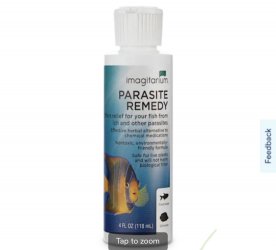I can't help with the product you want info about. However, fish rubbing on objects and breathing heavily can be a sign of poor water quality (ammonia, nitrite or nitrate), or an external protozoan infection like white spot or velvet.
----------------------
Can you post some pictures and a video of the fish rubbing and breathing?
A video about 60seconds long is fine and can be uploaded to YouTube, then copy & paste the link here.
What is the ammonia, nitrite, nitrate and pH of the tank water?
Do the fish have any small white spots on their body or fins?
Turn the tank light off and shine a torch on the fish. See if they have a yellow/ gold sheen over any part of their body. You can also use a camera with its flash ON, to take a picture of the fish and see if there is any yellow/ gold sheen on their body.
If there is a yellow/ gold sheen on all or part of the body, the fish have velvet.
----------------------
White spot and velvet can both be treated with heat. Raise the water temperature to 30C (86F) and keep it there for 2 weeks, or at least 1 week after all the white spots or yellow/ gold sheen has gone. Then turn the temperature down to whatever it normally is.
You can insulate the base, back and sides of the tank with polystyrene foam sheets to help keep the temperature warm. And have a coverglass on top of the tank if you don't already have one. Coverglass should be made from glass that is 4mm, 5mm or 6mm thick, (4mm thick for smaller tanks). Thinner glass tends to chip and crack more readily.
The Corydoras and Betta will be fine at this temperature for a few weeks.
Before raising the temperature, do a 80-90% water change and gravel clean the substrate. This will remove most of the disease organisms in the tank and give the fish a few less parasites to deal with while the heat does its job.
Make sure any new water is free of chlorine/ chloramine before it's added to the tank.
You should also clean the filter if it is more than 6 weeks old, or hasn't been done in the last 2 weeks. Wash the filter media/ material in a bucket of tank water and re-use the media. Tip the bucket of dirty water on the garden/ lawn.
Wash the filter case and impellor assembly under tap water.


